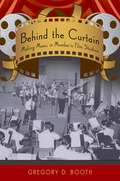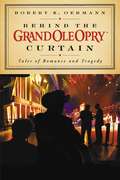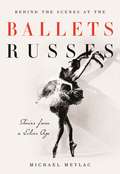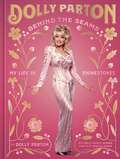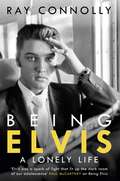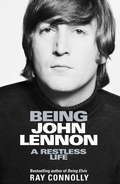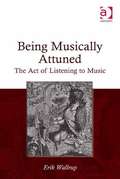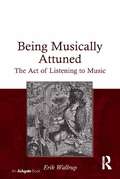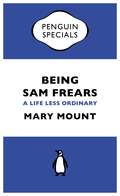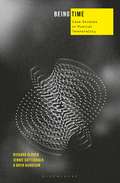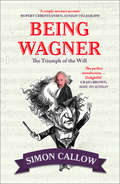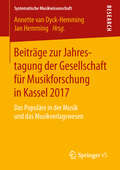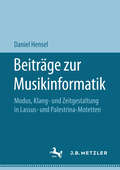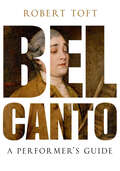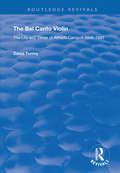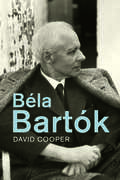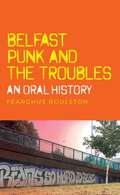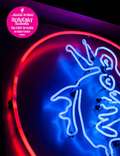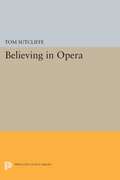- Table View
- List View
Behind the Curtain: Making Music in Mumbai's Film Studios
by Gregory D. BoothBeginning in the 1930s, men and a handful of women came from India's many communities-Marathi, Parsi, Goan, North Indian, and many others--to Mumbai to work in an industry that constituted in the words of some, "the original fusion music." They worked as composers, arrangers, assistants, and studio performers in one of the most distinctive popular music and popular film cultures on the planet. Today, the songs played by Mumbai's studio musicians are known throughout India and the Indian diaspora under the popular name "Bollywood," but the musicians themselves remain, in their own words, "behind the curtain"--the anonymous and unseen performers of one of the world's most celebrated popular music genres. Now, Gregory D. Booth offers a compelling account of the Bollywood film music industry from the perspective of the musicians who both experienced and shaped its history. In a rare insider's look at the process of musical production from the late 1940s to the mid 1990s, before the advent of digital recording technologies, Booth explains who these unknown musicians were and how they came to join the film music industry. On the basis of a fascinating set of first-hand accounts from the musicians themselves, he reveals how the day-to-day circumstances of technology and finance shaped both the songs and the careers of their creator and performers. Booth also unfolds the technological, cultural, and industrial developments that led to the enormous studio orchestras of the 1960s-90s as well as the factors which ultimately led to their demise in contemporary India. Featuring an extensive companion website with video interviews with the musicians themselves, Behind the Curtain is a powerful, ground-level view of this globally important music industry.
Behind the Grand Ole Opry Curtain: Tales of Romance and Tragedy
by Robert K. Oermann Grand Ole OpryThe Grand Ole Opry has been home to the greatest legends of country music for over eighty years, and in that time it has seen some of conutry music's most dramatic stories unfold. We'll hear of the great love stories ranging from Johnny Cash and June Carter in the 1960s to Garth Brooks and Trisha Yearwood, who married in 2005. We'll get the truth of the tragedies that led to the loss of three stars all in the same month, starting the rumor of the "Opry Curse." We'll learn how after being stabbed, shot, and maimed, Trace Adkins calls his early honky-tonk years "combat country," and we'll find inspiration from DeFord Bailey, an African American harmonica player in 1927 crippled by childhood polio who rose to fame as one of the first Opry stars. Our hearts will break for Willie Nelson, who lost his only son on Christmas Day, and soar for Amy Grant and Vince Gill, who found true love. Based on over 150 firsthand interviews with the stars of The Grand Ole Opry, these are stories that tell the heart of country--the lives that are lived and inspire the songs we love.
Behind the Scenes at the Ballets Russes: Stories from a Silver Age
by Michael MeylacThe Ballets Russes was perhaps the most iconic, yet at the same time mysterious, ballet company of the twentieth century. Inspired by the unique vision of their founder Sergei Diaghilev, the company gained a large international following. In the mid-twentieth century – during the tumultuous years of World War II and the Cold War – the Ballets Russes companies kept the spirit and traditions of Russian ballet alive in the West, touring extensively in America, Europe and Australia. This important new book uncovers previously-unseen interviews and provides insights into the lives of the great figures of the age – from the dancers Anna Pavlova and Alicia Markova to the choreographers Leonide Massine, George Balanchine and Anton Dolin. The dancers' own words reveal what life was really like for the stars of the Ballets Russes and provide fascinating new insights into one of the most vibrant and creative groups of artists of the modern age.
Behind the Seams: My Life in Rhinestones
by Dolly Parton'I hope that as you gaze upon my life in clothing, it will inspire you to develop, and celebrate, your own sense of style. I value my freedom to look like and be my own true self more than anything else, and I hope this book will also give you the confidence to look like and be the person you want to be. Whoever you are, be that! And enjoy your journey behind the seams' - DollyA beautifully illustrated celebration of Dolly Parton's iconic sense of style through entertaining personal stories and 450 full-color photographs, including exclusive images from her private costume archive.In Behind the Seams: My Life in Rhinestones, global superstar Dolly Parton shares, for the first time, the full story behind her lifelong passion for fashion, including how she developed her own, distinctly Dolly style, which has defied convention and endeared her to fans around the world.Featuring behind-the-scenes stories from Dolly Parton's life and career, and the largest reveal of her private costume archive, this gorgeously photographed book spotlights her most unforgettable looks from the 1960s to now. The sky-high heels, famous wigs, bold makeup, eye-catching stage clothes - she shares them all. Along the way, Parton discusses memorable outfits from her past, from the clothes her mother would sew out of feed sacks (including her "Coat of Many Colors") and the bold dresses and hairdos that shook up Nashville, to the bunny suit on the cover of Playboy, evening wear at Studio 54, costumes from her most famous film and TV roles, and the daring styles that continue to entertain and inspire today.Filled with candor, humor, and lots and lots of rhinestones, Behind the Seams: My Life in Rhinestones is a shining tribute to one of the most beloved musicians in history, a treasured keepsake for anyone who loves Dolly Parton, and an indispensable guide to forging your own path to beauty and confidence.
Being Elvis: The perfect companion to Baz Luhrmann’s major biopic
by Ray ConnollyThe perfect companion to Baz Luhrmann's forthcoming biopic Elvis, a major motion picture starring Tom Hanks and Austin Butler.What was it like to be Elvis Presley? What did it feel like when impossible fame made him its prisoner? As the world's first rock star there was no one to tell him what to expect, no one with whom he could share the burden of being himself - of being Elvis.On the outside he was all charm, sex appeal, outrageously confident on stage and stunningly gifted in the recording studio. To his fans he seemed to have it all. He was Elvis. With his voice and style influencing succeeding generations of musicians, he should have been free to sing any song he liked, to star in any film he was offered, and to tour in any country he chose. But he wasn't free. The circumstances of his poor beginnings in the American South, which, as he blended gospel music with black rhythm and blues and white country songs, helped him create rock and roll, had left him with a lifelong vulnerability. Made rich and famous beyond his wildest imaginings when he mortgaged his talent to the machinations of his manager, 'Colonel' Tom Parker, there would be an inevitable price to pay. Though he daydreamed of becoming a serious film actor, instead he grew to despise his own movies and many of the songs he had to sing in them. He could have rebelled. But he didn't. Why? In the Seventies, as the hits rolled in again, and millions of fans saw him in a second career as he sang his way across America, he talked of wanting to tour the world. But he never did. What was stopping him?BEING ELVIS takes a clear-eyed look at the most-loved entertainer ever, and finds an unusual boy with a dazzling talent who grew up to change popular culture; a man who sold a billion records and had more hits than any other singer, but who became trapped by his own frailties in the loneliness of fame.
Being John Lennon: A Restless Life
by Ray ConnollyJohn Lennon was a rock star, a school clown, a writer, a wit, an iconoclast, a sometime peace activist and finally an eccentric millionaire. He was also a Beatle - his plain-speaking and impudent rejection of authority catching, and eloquently articulating, the group's moment in history.Chronicling a troubled life, from that of the cast-aside child of a broken wartime marriage to his murder by a deranged fan, Being John Lennon analyses the contradictions in the singer-songwriter's creative and destructive personality. A leader who could be easily led, he was often generous and often funny, but sometimes scathingly cruel.As a journalist, author Ray Connolly had a close working relationship with Lennon, and the entire Beatles coterie. In this biography he unsparingly reassesses the chameleon nature of the perpetually dissatisfied star who just couldn't stop reinventing himself. Drawing on many interviews and conversations with Lennon, his first wife Cynthia and second Yoko Ono, as well as his girlfriend May Pang and song-writing partner Paul McCartney, this complex portrait is a revealing insight into a restless man whose emotional turbulence governed his life and talent.
Being Musically Attuned: The Act Of Listening To Music (PDF)
by Erik WallrupListening according to mood is likely to be what most people do when they listen to music. We want to take part in, or even be part of, the emerging world of the musical work. Using the sources of musical history and philosophy, Erik Wallrup explores this extremely vague and elusive phenomenon, which is held to be fundamental to musical hearing. Wallrup unfolds the untold musical history of the German word for 'mood', Stimmung, which in the 19th century was abundant in the musical aesthetics of the German-Austrian sphere. Martin Heidegger's much-discussed philosophy of Stimmung is introduced into the field of music, allowing Wallrup to realise fully the potential of the concept. Mood in music, or, to be more precise, musical attunement, should not be seen as a peculiar kind of emotionality, but that which constitutes fundamentally the relationship between listener and music. Exploring mood, or attunement, is indispensable for a thorough understanding of the act of listening to music.
Being Musically Attuned: The Act Of Listening To Music
by Erik WallrupListening according to mood is likely to be what most people do when they listen to music. We want to take part in, or even be part of, the emerging world of the musical work. Using the sources of musical history and philosophy, Erik Wallrup explores this extremely vague and elusive phenomenon, which is held to be fundamental to musical hearing. Wallrup unfolds the untold musical history of the German word for 'mood', Stimmung, which in the 19th century was abundant in the musical aesthetics of the German-Austrian sphere. Martin Heidegger's much-discussed philosophy of Stimmung is introduced into the field of music, allowing Wallrup to realise fully the potential of the concept. Mood in music, or, to be more precise, musical attunement, should not be seen as a peculiar kind of emotionality, but that which constitutes fundamentally the relationship between listener and music. Exploring mood, or attunement, is indispensable for a thorough understanding of the act of listening to music.
Being Musically Attuned: The Act of Listening to Music
by Erik WallrupListening according to mood is likely to be what most people do when they listen to music. We want to take part in, or even be part of, the emerging world of the musical work. Using the sources of musical history and philosophy, Erik Wallrup explores this extremely vague and elusive phenomenon, which is held to be fundamental to musical hearing. Wallrup unfolds the untold musical history of the German word for ’mood’, Stimmung, which in the 19th century was abundant in the musical aesthetics of the German-Austrian sphere. Martin Heidegger’s much-discussed philosophy of Stimmung is introduced into the field of music, allowing Wallrup to realise fully the potential of the concept. Mood in music, or, to be more precise, musical attunement, should not be seen as a peculiar kind of emotionality, but that which constitutes fundamentally the relationship between listener and music. Exploring mood, or attunement, is indispensable for a thorough understanding of the act of listening to music.
Being Musically Attuned: The Act of Listening to Music
by Erik WallrupListening according to mood is likely to be what most people do when they listen to music. We want to take part in, or even be part of, the emerging world of the musical work. Using the sources of musical history and philosophy, Erik Wallrup explores this extremely vague and elusive phenomenon, which is held to be fundamental to musical hearing. Wallrup unfolds the untold musical history of the German word for ’mood’, Stimmung, which in the 19th century was abundant in the musical aesthetics of the German-Austrian sphere. Martin Heidegger’s much-discussed philosophy of Stimmung is introduced into the field of music, allowing Wallrup to realise fully the potential of the concept. Mood in music, or, to be more precise, musical attunement, should not be seen as a peculiar kind of emotionality, but that which constitutes fundamentally the relationship between listener and music. Exploring mood, or attunement, is indispensable for a thorough understanding of the act of listening to music.
Being Sam Frears: A Life Less Ordinary (Penguin Specials)
by Mary MountThis is Sam Frears' story.This is also the story of an actor, a rock-climber and a man born with an extremely rare genetic disorder only affecting Ashkenazi Jews. Sam was supposed to live to the age of 5. In February, he celebrated his 40th birthday.Challenged by blindness and a body under great stress, Sam Frears is trying to live an ordinary life under extraordinary circumstances His struggles and triumphs offer an illuminating look at the differences - and similarities - that make us human. For those who enjoyed My Left Foot and Stuart: A Life Backwards, this Penguin Special offers a fresh look at what it's like to be Sam.
Being Time: Case Studies in Musical Temporality
by Jennie Gottschalk Richard Glover Bryn HarrisonBeing Time invites a deep consideration of the personal experience of temporality in music, focusing on the perceptual role of the listener. Through individual case studies, this book centers on musical works that deal with time in radical ways. These include pieces by Morton Feldman, James Saunders, Chiyoko Szlavnics, Ryoji Ikeda, Toshiya Tsunoda, Laurie Spiegel and André O. Möller. Multiple perspectives are explored through a series of encounters, initially between an individual and a work, and subsequently with each author's varying experiences of temporality. The authors compare their responses to features such as repetition, speed, duration and scale from a perceptual standpoint, drawing in reflections on aspects such as musical memory and anticipation. The observations made in this book are accessible and relevant to readers who are interested in exploring issues of temporality from a broad range of disciplinary perspectives.
Being Time: Case Studies in Musical Temporality
by Jennie Gottschalk Richard Glover Bryn HarrisonBeing Time invites a deep consideration of the personal experience of temporality in music, focusing on the perceptual role of the listener. Through individual case studies, this book centers on musical works that deal with time in radical ways. These include pieces by Morton Feldman, James Saunders, Chiyoko Szlavnics, Ryoji Ikeda, Toshiya Tsunoda, Laurie Spiegel and André O. Möller. Multiple perspectives are explored through a series of encounters, initially between an individual and a work, and subsequently with each author's varying experiences of temporality. The authors compare their responses to features such as repetition, speed, duration and scale from a perceptual standpoint, drawing in reflections on aspects such as musical memory and anticipation. The observations made in this book are accessible and relevant to readers who are interested in exploring issues of temporality from a broad range of disciplinary perspectives.
Beiträge zur Jahrestagung der Gesellschaft für Musikforschung in Kassel 2017: Das Populäre in der Musik und das Musikverlagswesen (Systematische Musikwissenschaft)
by Annette van Dyck-Hemming Jan HemmingDieses Buch versammelt Ansätze der Musikwissenschaft, die auf der Tagung der Gesellschaft für Musikforschung in Kassel 2017 diskutiert wurden. Studien zu Gitarrenriffs im Heavy Metal, Vokalmusik der Renaissance oder Techno stehen dabei neben Untersuchungen zum Einfluss Th. W. Adornos auf die Forschung und Forderungen, populäre Musik ernst zu nehmen. Zweiter Themenschwerpunkt sind Verlage, ihre Netzwerke und ihr Verhältnis u. a. zu Beethoven sowie Fragen zu Urheberrecht und digitaler Publikation. Der Band dokumentiert die Vielfalt musikologischer Forschung, die sich mit Musikwirtschaft und -software, Aufnahmetechnik, aber auch Instrumentenbau, Klaviersonaten und der Freundschaft zwischen Luciano Berio und Umberto Eco beschäftigt, und gibt so Antworten auf aktuelle und historische musikalische Fragen.
Beiträge zur Musikinformatik: Modus, Klang- und Zeitgestaltung in Lassus- und Palestrina-Motetten
by Daniel HenselDaniel Hensels Studie bietet einen völlig neuen Blick auf die Entwicklung der Tonalität. Es wurden neben einfachen statistischen Verfahren spezielle Klanganalyse-Visualisierungen erarbeitet, die die Entwicklung der Klangqualität in ihrer zeitlichen Ausprägung über ganze Werkgruppen hinweg darstellen können. Ziel war es herauszufinden, wie sehr die Modi die Harmonik determinieren, ob sie sich statistisch voneinander unterscheiden und sich dadurch in ihrer Existenz beweisen lassen. Hierfür entwickelte der Autor zusammen mit dem Informatiker Ingo Jache den PALESTRiNIZER. Mit ihm untersuchte er die Möglichkeiten der computergestützten automatisierten Musikanalyse anhand des Verhältnisses von Modus und Klang in 253 Motetten von Lassus und Palestrina.
Bel Canto: A Performer's Guide
by Robert ToftBel canto, or 'beautiful singing,' remains one of the most elusive performance styles vocalists strive to master. During the eighteenth and early nineteenth centuries, composers routinely left the final shaping of recitatives, arias, and songs to performers, and singers treated scores freely so that inexpressively notated music could be turned into passionate declamation. In other words, vocalists saw their role more as one of re-creation than of simple interpretation. Familiarity with the range of strategies prominent singers of the past employed to unlock the eloquent expression hidden in scores enables modern performers to take a similar re-creative approach to enhancing the texts before them. In this first ever guide to bel canto, author Robert Toft provides singers with the tools they need not only to complete the creative process the composer began but also to bring scores to life in an historically-informed manner. Replete with illustrations based on excerpts from Italianate recitatives and arias by composers ranging from Handel to Rossini, the book offers discussions of the fundamental principles of expressive singing, each section including a practical application of the techniques involved. Drawing on a wealth of documents from the era, including treatises, scores, newspaper reviews, and letters, this book captures the breadth of practices singers used in the bel canto period. Complete with six scores (recitatives and/or arias) for performers to personalize through the old methods, and a companion website offering demonstrations of the principles involved, Bel Canto is an essential resource for any singer or vocal instructor wishing to explore and master historical techniques of interpretation and re-creation from the eighteenth and early nineteenth centuries.
Bel Canto: A Performer's Guide
by Robert ToftBel canto, or 'beautiful singing,' remains one of the most elusive performance styles vocalists strive to master. During the eighteenth and early nineteenth centuries, composers routinely left the final shaping of recitatives, arias, and songs to performers, and singers treated scores freely so that inexpressively notated music could be turned into passionate declamation. In other words, vocalists saw their role more as one of re-creation than of simple interpretation. Familiarity with the range of strategies prominent singers of the past employed to unlock the eloquent expression hidden in scores enables modern performers to take a similar re-creative approach to enhancing the texts before them. In this first ever guide to bel canto, author Robert Toft provides singers with the tools they need not only to complete the creative process the composer began but also to bring scores to life in an historically-informed manner. Replete with illustrations based on excerpts from Italianate recitatives and arias by composers ranging from Handel to Rossini, the book offers discussions of the fundamental principles of expressive singing, each section including a practical application of the techniques involved. Drawing on a wealth of documents from the era, including treatises, scores, newspaper reviews, and letters, this book captures the breadth of practices singers used in the bel canto period. Complete with six scores (recitatives and/or arias) for performers to personalize through the old methods, and a companion website offering demonstrations of the principles involved, Bel Canto is an essential resource for any singer or vocal instructor wishing to explore and master historical techniques of interpretation and re-creation from the eighteenth and early nineteenth centuries.
The Bel Canto Violin: The Life and Times of Alfredo Campoli, 1906-1991 (Routledge Revivals)
by David TunleyFirst published in 1999, this biography from David Tunley draws on newly researched documentary evidence to chart Campoli’s early success and his later struggle for recognition as a serious artist. Campoli’s early success and his later struggle for recognition as a serious artist. Campoli’s career emerges as one particularly shaped and directed by the great economic and social forces of the first half of the century, and the story here is as much that of his times, as of his life. Described by Szigeti as ‘one of the last great individualists among violinists’, Alfredo Campoli was a household name in the field of British light music prior to the Second World War. Having made his début at the Wigmore Hall in 1923 Campoli toured with Melba and Butt, then turned to light music during the Depression. He became one of Decca’s early recording artists and broadcast frequently for the BBC with his light music ensembles and pursued a long, successful career as a distinguished international performer.
The Bel Canto Violin: The Life and Times of Alfredo Campoli, 1906-1991 (Routledge Revivals)
by David TunleyFirst published in 1999, this biography from David Tunley draws on newly researched documentary evidence to chart Campoli’s early success and his later struggle for recognition as a serious artist. Campoli’s early success and his later struggle for recognition as a serious artist. Campoli’s career emerges as one particularly shaped and directed by the great economic and social forces of the first half of the century, and the story here is as much that of his times, as of his life. Described by Szigeti as ‘one of the last great individualists among violinists’, Alfredo Campoli was a household name in the field of British light music prior to the Second World War. Having made his début at the Wigmore Hall in 1923 Campoli toured with Melba and Butt, then turned to light music during the Depression. He became one of Decca’s early recording artists and broadcast frequently for the BBC with his light music ensembles and pursued a long, successful career as a distinguished international performer.
Béla Bartók
by Prof. David Cooper"This deeply researched biography of Béla Bartók (1881–1945) provides a more comprehensive view of the innovative Hungarian musician than ever before. David Cooper traces Bartók’s international career as an ardent ethno-musicologist and composer, teacher, and pianist, while also providing a detailed discussion of most of his works. Further, the author explores how Europe’s political and cultural tumult affected Bartók’s work, travel, and reluctant emigration to the safety of America in his final years. Cooper illuminates Bartók’s personal life and relationships, while also expanding what is known about the influence of other musicians—Richard Strauss, Zoltán Kodály, and Yehudi Menuhin, among many others. The author also looks closely at some of the composer’s actions and behaviors which may have been manifestations of Asperger syndrome. The book, in short, is a consummate biography of an internationally admired musician."
Belfast punk and the Troubles: An oral history
by Fearghus RoulstonBelfast punk and the Troubles is an oral history of the punk scene in Belfast from the mid-1970s to the mid-80s. The book explores what it was like to be a punk in a city shaped by the violence of the Troubles, and how this differed from being a punk elsewhere. It also asks what it means to have been a punk – how punk unravels as a thread throughout the lives of the people interviewed, and what that unravelling means in the context of post-peace-process Northern Ireland. In doing so, it suggests a critical understanding of sectarianism, subjectivity and memory politics in the North, and argues for the importance of placing punk within the segregated structures of everyday life described by the interviewees.Adopting an innovative oral history approach drawing on the work of Luisa Passerini and Alessandro Portelli, the book analyses a small number of oral history interviews with participants in granular detail. Outlining the historical context and the cultural memory of punk, the central chapters each delve into one or two interviews to draw out the affective, imaginative and political ways in which punks and former punks evoke their memories of taking part in the scene. Through this method, it analyses the punk scene as a structure of feeling shaped through the experience of growing up in wartime Belfast.Belfast punk and the Troubles is an intervention in Northern Irish historiography stressing the importance of history from below, and will be compelling reading for historians of Ireland and of punk, as well as those interested in innovative approaches to oral history.
Belfast punk and the Troubles: An oral history
by Fearghus RoulstonBelfast punk and the Troubles is an oral history of the punk scene in Belfast from the mid-1970s to the mid-80s. The book explores what it was like to be a punk in a city shaped by the violence of the Troubles, and how this differed from being a punk elsewhere. It also asks what it means to have been a punk – how punk unravels as a thread throughout the lives of the people interviewed, and what that unravelling means in the context of post-peace-process Northern Ireland. In doing so, it suggests a critical understanding of sectarianism, subjectivity and memory politics in the North, and argues for the importance of placing punk within the segregated structures of everyday life described by the interviewees.Adopting an innovative oral history approach drawing on the work of Luisa Passerini and Alessandro Portelli, the book analyses a small number of oral history interviews with participants in granular detail. Outlining the historical context and the cultural memory of punk, the central chapters each delve into one or two interviews to draw out the affective, imaginative and political ways in which punks and former punks evoke their memories of taking part in the scene. Through this method, it analyses the punk scene as a structure of feeling shaped through the experience of growing up in wartime Belfast.Belfast punk and the Troubles is an intervention in Northern Irish historiography stressing the importance of history from below, and will be compelling reading for historians of Ireland and of punk, as well as those interested in innovative approaches to oral history.
Believe in Magic: 30 Years of Heavenly Recordings
by Robin Turner'Heavenly is more than a record label, it's the absolute nectar of all that's brilliant in the culture of these island. I love the shit out of them and everything they stand for.' Irvine WelshBELIEVE IN MAGIC tells the story of Heavenly Recordings in thirty vignettes, photography and ephemera, all of which relate to landmark records, moments and characters in the label's first three decades.A label responsible for creating satellite communities of fans around the world and at all the major festivals, Heavenly was set up by Jeff Barrett in 1990 after several years working for Factory and Creation as the acid house revolution was in full swing; early releases set the tone and tempo for the mood of the decade to come - their first single was produced by perhaps the most revered acid house DJ of them all, Andrew Weatherall; and this was quickly followed by era-defining singles from Saint Etienne, Flowered Up and Manic Street Preachers, music which perhaps captures the flavour of the early '90s better than any other.Heavenly was always tuned to an aesthetic that was sensitive to the anarchic spirt of the times; defiantly eclectic with a radar set to taste and a never-ending commitment to discovering new talent. In 1994 they set up The Heavenly Sunday Social, which became one of the most influential and mythologised clubs in recent British history, where the Chemical Brothers - then the Dust Brothers - made their name. For thirteen weeks, it was the hottest nightclub on the planet. For 180 demented acolytes in a basement room below the Albany pub.Over nearly 200 releases in thirty years Heavenly have consistently produced some of the most exciting music across all genres, and this book collects rare artwork and wild anecdotal evidence into a celebration of a label that is one of the most beloved institutions on the independent landscape.BELIEVE IN MAGIC includes contributions from Manic Street Preachers, Beth Orton, Doves, Don Letts, Edwyn Collins, Confidence Man, Mark Lanegan, King Gizzard and The Lizard Wizard.
Believing in Opera (PDF)
by Tom SutcliffeThe staging of opera has become immensely controversial over the last twenty years. Tom Sutcliffe here offers an engaging and far-reaching book about opera performance and interpretation. This work is a unique tribute to the most distinctive and adventurous achievements in the theatrical interpretation of opera as it has developed in recent decades. Readers will find descriptions of the most original and successful avant-garde opera productions in Britain, Europe, and America. Sutcliffe beautifully illustrates how updating, transposition, or relocation, and a variety of unexpected imagery in opera, have qualified and adjusted our perception of the content and intention of established masterpieces.Believing in Opera describes in detail the seminal opera productions of the last fifty years, starting with Peter Brook in London after the war, and continuing with the work of such directors and producers as Patrice Chéreau in Bayreuth, Peter Sellars and David Alden in America, Ruth Berghaus in Frankfurt, and such British directors as Richard Jones, Graham Vick, Peter Hall, and David Pountney. Through his descriptions of these works, Sutcliffe states that theatrical opera has been enormously influenced by the editing style, imagery, and metaphor commonplace in the cinema and pop videos. The evolution of the performing arts depends upon revitalization and defamiliarization, he asserts. The issue is no longer naturalism, but the liberation of the audience's imagination powered by the music.Sutcliffe, an opera critic for many years, argues that opera is theater plus music of the highest expressive quality, and as a result he has often sided with unconventional and novel theatrical interpretations. He believes that there is more to opera than meets the ear, and his aim is to further the process of understanding and interpretation of these important opera productions. No other book has attempted this kind of monumental survey.Originally published in 1997.The Princeton Legacy Library uses the latest print-on-demand technology to again make available previously out-of-print books from the distinguished backlist of Princeton University Press. These editions preserve the original texts of these important books while presenting them in durable paperback and hardcover editions. The goal of the Princeton Legacy Library is to vastly increase access to the rich scholarly heritage found in the thousands of books published by Princeton University Press since its founding in 1905.
